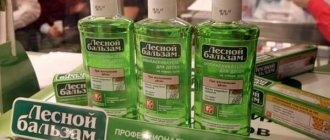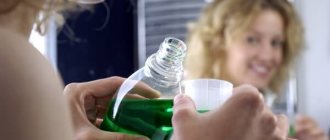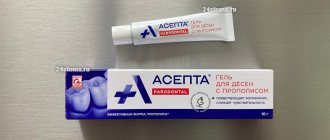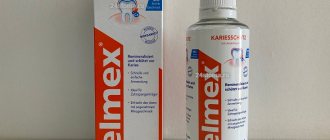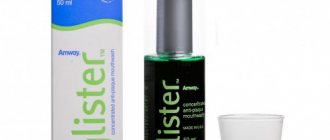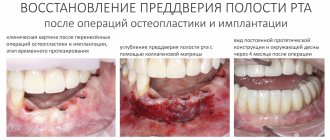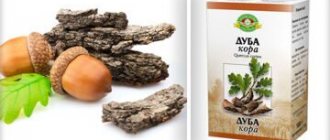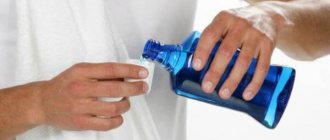Causes of bleeding gums
If you are interested in the mechanism of how poor hygiene and gum inflammation lead to bleeding, it looks like this.
Plaque and tartar bacteria produce a large number of toxins and various pathogens that trigger a chain of inflammatory reactions in the gums. In particular, this leads to increased permeability and fragility of capillaries (which is due to the fact that blood appears precisely when brushing teeth), as well as to swelling, redness or cyanosis of the gingival papillae. In parallel with this, the process of desquamation (squamation) of epithelial cells of the gum mucosa intensifies, which leads to thinning of the epithelium. The latter further reduces the resistance of gums weakened by inflammation to mechanical stress, for example, when brushing teeth or chewing hard food. Therefore, when together: 1) fragility and increased permeability of capillaries, 2) thinning of the epithelium + 3) even completely normal mechanical stress, it ends in bleeding when brushing your teeth.
By the way, a very common symptom that accompanies bleeding gums is pain when brushing your teeth. The mechanism of its development is also associated with thinning of the epithelium of the gum mucosa and a decrease in the latter’s resistance to mechanical stress. And the conclusion that needs to be drawn from all of the above is that treatment should not be tied to the fight against a separate symptom of bleeding; it should consist in eliminating the main cause of gum inflammation, i.e. removal of microbial plaque and tartar.
Causes of bleeding from gums
Injury to gum tissue
The mucous membrane of the gums can be damaged when brushing your teeth with a brush that is too hard or if used incorrectly:
- dental floss,
- toothpicks,
- and other hygiene products,
- when eating too rough food (hard cookies, crackers).
More serious bleeding may be caused by improper fitting of prosthetic devices (crowns, bridges, etc.).
Poor hygiene
In the absence of the required care, a plaque consisting of bacteria, mucus and food debris appears on the enamel. Subsequently, it is mineralized by calcium salts present in saliva and turns into dense tartar. The bacteria that make up plaque produce toxins that negatively affect the condition of the mucous epithelium of the gums and provoke the development of an inflammatory reaction. Against the background of inflammation, the blood vessels in the gum tissue become vulnerable, brittle and easily injured when eating or performing hygiene measures.
Irritation from tobacco product toxins
Irritation that occurs upon contact with chemicals. In particular, bleeding can be caused by toxins produced by burning tobacco or smoking mixtures. In addition, chemical irritants can be substances used in hazardous industries (asbestos, metal salts, perchlorethylene) or poorly selected hygiene products (pastes, rinses).
Hormonal imbalances
Hormonal changes are one of the most common causes of bleeding gums in pregnant women. Such manifestations are temporary: bleeding stops completely after the baby is born.
In addition, factors contributing to the development of bleeding gums are:
- unbalanced diet;
- serious disorders in the functioning of the body (leukemia, diabetes, hemophilia and others);
- long-term medication use;
- lack of vitamins;
- drinking alcohol too often;
- stress.
Factors predisposing to bleeding gums
If this is not the first time that you have experienced bleeding, this indicates that your gum inflammation is chronic and has been going on for quite a long time. In this case, when brushing your teeth, blood may appear and then disappear again (24stoma.ru). Typically, gums bleed only during exacerbations of chronic inflammation. Exacerbation of the inflammatory process most often occurs in the off-season and is associated with a decrease in immunity or the development of vitamin deficiency.
But we don’t want you to think that poor immunity or vitamin deficiency are the causes of exacerbations of gum inflammation and bleeding. The cause is still plaque bacteria. It’s just that local protective factors in the oral cavity (against the background of decreased immunity) no longer cope with the previous volume of toxins and pathogens released by microbial plaque on your teeth. Other predisposing factors may include mouth breathing and xerostomia, which contribute to an increase in the amount of plaque in the mouth.
Rinse aids from A to Z
It would seem that there is no need for instructions on the question of how to use mouthwash, but there are a number of rules that, if followed, will make the use of mouthwash most effective for the health of your teeth and gums.
Rule one: mouthwash is an additional hygiene product; it cannot replace regular teeth brushing, but can enhance its effectiveness. Brushing your teeth provides mechanical removal of plaque and should be done regularly. The mouthwash should be used after brushing your teeth to further cleanse the mouth of food debris and plaque. In this case, the effect of its use will be maximum.
Rule two: you must rinse correctly and thoroughly. Fill the mouthwash cap with 10-20 ml. Divide the mouth into four parts and rinse each thoroughly for 5-7 seconds. When rinsing, pay special attention to thoroughly clean the interdental spaces. In general, you need to rinse your mouth with mouthwash for at least 30 seconds. This time is necessary so that the interdental spaces are cleaned, and the active components of the mouthwash can act on the teeth and gums.
Rule three: very often the question arises: is it necessary to rinse your mouth after mouthwash? So, the answer is: no. There is no point in rinsing your mouth after using a rinse, since the rinse contains a large number of ingredients that linger on the teeth and gums and bring a long-lasting healing effect. If you rinse your mouth immediately after using the mouthwash, you will minimize the possible effect.
Rule four: mouth rinse is also effective to use after any meal; it will easily remove food debris from the mouth and prolong the freshness of your breath. When choosing between regular breath fresheners and mouthwash, give preference to mouthwash.
Rule five: if you are using a mouthwash for the first time, you may be unfamiliar with the intensity of its taste and freshness. In such cases, you can dilute the rinse aid with water, but reduce the dilution level over time.
Rule six: mouthwash should not be swallowed.
Watch short and simple instructions from the experts at the Forest Balm brand on how to use mouthwash correctly.
Even if you know how to use a dental rinse well and use an individually selected rinse, it cannot replace regular care! Mouth rinse is effective only as part of a complex of procedures for caring for teeth and gums. For complete hygiene, dentists recommend using a toothbrush, toothpaste, mouthwash and dental floss. The toothbrush and paste are designed to remove the bulk of soft plaque from the enamel of teeth and gums and carry out the first stage of oral health care and disease prevention. The next step should be the use of mouthwash and dental floss, which will most effectively clean hard-to-reach areas of periodontal disease and interdental spaces.
Mouthwash will help care for your teeth, maintain oral health and leave you feeling clean and fresh. Try it, and very soon it will become your new healthy habit!
What diseases are bleeding gums a symptom of?
Bleeding gums can be either an independent disease or a symptom of another. There are three oral diseases that can lead to bleeding:
- Periodontal disease. With periodontal disease, it is not so much the gums that are damaged as the soft tissue around them. Due to the damage to these tissues, which dentists call periodontium, there is an increase in the amount of plaque on the teeth, which leads to microtrauma of the gums. With periodontal disease, tooth pockets do not form, and the gums themselves become inflamed quite rarely.
- Periodontitis. With periodontitis, both the gums and the soft tissue around them are damaged. The disease progresses very quickly. If left untreated, symptoms such as gradual destruction of the alveolar process, inflammation of the gums and soft tissues, formation of dental pockets (which often fester), and so on are observed. Periodontitis is relatively common.
- Gingivitis. Gingivitis causes damage to the gums. If gingivitis is not treated, it evolves into periodontitis.
What to do if your gums bleed: treatment
If your gums bleed when brushing your teeth, treatment should be carried out by a periodontist (these doctors do not specialize in the treatment of gums). The most important thing to do at the first stage of treatment is to remove the causative factor in the development of gum inflammation, i.e. carry out ultrasonic cleaning of teeth from microbial plaque and tartar. This can only be done by a dentist. But the course of anti-inflammatory therapy following the cleansing can be carried out at home.
Treatment at the dentist's office
Treatment of bleeding gums when brushing teeth includes removing plaque from enamel and tartar and rinsing deep periodontal pockets for periodontitis and periodontal disease. These manipulations are carried out by a specialist in the clinic’s office.
To remove dental plaque, ultrasonic cleaning is used, less often - the use of instruments and mechanical cleaning of the enamel. The number of sessions required depends on the complexity of the work and the amount of deposits.
Washing of periodontal pockets is carried out in chronic forms of periodontitis and periodontal disease. It helps remove pathogenic microbes, their waste products, pus and exudate. The solutions used have antibacterial, antimicrobial and anti-inflammatory effects.
Forest Balm Rinse for gums oak-fir bark 250ml
Description
Preventive mouth rinse Forest balm based on herbal decoction has an immunoactive effect, helps solve the problem of bleeding gums and improves the functioning of the oral cavity’s own immunity by 2 times, reducing the risk of developing gum problems*. Clinically proven effect: • Improves the condition of the gums from the first use* • Reduces bleeding gums by up to 94% with regular use** • Reduces the rate of plaque formation on teeth by 5 times, reducing the bacterial load on the soft tissues of the oral cavity** • does not upset the balance microflora of the oral cavity Features of the composition: Rich pine taste. Contains a coniferous complex (based on extracts of fir, resin, juniper) with a decoction of 5 medicinal herbs, oak bark extract and aloe juice. This balanced composition helps strengthen the blood vessels of the gums, improves blood circulation and nutrition in the soft tissues of the oral cavity, and prevents the recurrence of bleeding when brushing your teeth. Recommendations: • The rinse is approved by the Russian Dental Association and is recommended as a prophylactic for inflammation and bleeding gums (gingivitis, periodontitis). • Use after each brushing of teeth, as well as after meals to clean the interdental spaces. Fill the cap with mouthwash and rinse your mouth thoroughly for 30 seconds. • No need to rinse with water after use. • If your gums are bleeding, it is recommended to use Forest Balm together with toothpaste after each brushing of your teeth, and also rinse your mouth thoroughly after each meal. During the period of remission, maintain use at least once a day to prevent the development of gum problems and improve nutrition of the soft tissues of the oral cavity. • Suitable for use in an irrigator. • Suitable for use during pregnancy and lactation *Forest balm supports the immune system and enhances the effectiveness of the natural protective functions of the oral cavity. Properties confirmed by clinical trials in the Russian Federation, 2016 - 2022. **When using toothpaste and rinse together, Forest balm based on a pine complex with a decoction of herbs according to clinical trials, after 1 month of use, Russia 2017
Compound
Aqua, Glycerin, PEG-40 Hydrogenated Castor Oil, Quercus Alba Bark Extract, Abies Sibirica Leaf Extract, Aloe Barbadensis Leaf Juice, Urtica Dioica (Nettle) Leaf Powder, Chamomilla Recutita (Matricaria) Flower Extract, Achillea Millefolium Extract, Hypericum Perforatum Flower/ Leaf/Stem Extract, Chelidonium Majus Extract, Turpentine, Juniperus Communis Fruit Extract, Sodium Fluoride, Cetylpyridinium Chloride, Aroma, Citric Acid, Disodium EDTA, Glycine Soja (Soybean) Oil, Phenoxyethanol, PVM/MA Copolymer, Sodium Hydroxide, Sodium Saccharin, Sodium Sulfite, Benzyl Alcohol, Limonene, CI 19140, CI 42090
Application
Fill the cap with rinse aid. Rinse your mouth thoroughly for 30 seconds. Use after meals, before and after brushing your teeth at least twice a day. Precautions: Contains sodium fluoride. Age 14+ Store at temperatures from 0 to +25 °C
Gels and toothpastes for bleeding
You should choose a toothpaste based on what is causing your gums to bleed. The composition may contain different components: potassium chloride, sodium sulfate, vitamins, medicinal plants, etc.
The most effective and popular means to solve the problem:
- SPLAT Professional Active is a Russian toothpaste, its distinctive feature is its black color. It has several actions at once - antiseptic, hemostatic. The main components included in the composition are skullcap, spirulina extract, and bergenia extract.
- Lacalut Activ is a whole complex that includes a toothbrush, toothpaste and mouthwash. Aluminum cations are used as a basis.
- Parodontax Classic – contains extracts of medicinal herbs. The pasta is produced not in our country, but in the UK.
- Forest balsam is another domestic product that contains many components of plant origin. There is sea buckthorn essential oil, St. John's wort, chamomile and more.
Recommended toothpaste for treatment
Dental gels are no less effective. It is recommended to use Cholisal, Parodium, Solcoseryl, Metrogil Dent, etc.
Interesting!
It is recommended to change toothpastes periodically, this way you can achieve comprehensive care.
Whitening pastes should never be used for bleeding gums. The thing is that they can irritate the gums, thereby further aggravating the situation. In the video in this article you can learn in more detail about which toothpastes and gels are useful for this problem.
Methods for preventing bleeding gums
Preventing bleeding gums is much easier than dealing with the manifestations of the onset of the disease.
In order to reduce the risk of developing this pathology, it is necessary:
- carefully observe all the requirements of oral hygiene (brushing your teeth thoroughly using soft toothbrushes and flosses, cleaning the surface of the tongue from pathological plaque, changing toothpastes from time to time, choosing options with different contents of fluoride, calcium and other useful substances);
- regularly (at least once every six months) remove dental plaque, which serves as an excellent breeding ground for harmful microorganisms;
- rinse the mouth after eating (for rinsing, you can use plain water, special solutions or decoctions of medicinal plants (sage, oak bark, etc.);
- exclude from the diet foods that are too salty, spicy and sour, which irritate the gum tissue;
- stick to a moderate carbohydrate diet;
- enrich your diet with foods rich in vitamins and calcium.
It is important to remember that self-treatment of dental diseases most often not only does not bring the expected effect, but also contributes to the development of complications. That is why, if you notice even slight bleeding of the gums, it is recommended to seek professional advice from a doctor as soon as possible.
Antiseptics for rinsing
Mouth rinse
To rinse the mouth, you should take products with antibacterial and anti-inflammatory effects. In order to enhance overall healing, they are usually used as a supplement.
So, what do dentists recommend:
- Miramistin 0.01%. The drug is especially effective for herpes infections, has a calming and antimicrobial effect.
- Stomatophyte – contains medicinal herbs and alcohol. Recommended for use in the development of gingivitis and periodontal disease.
- Polyminerol – stops bleeding, accelerates regeneration processes.
- Chlorhexidine, concentration not more than 0.05%. This is an antibacterial agent used for inflammatory processes. In addition, dentists recommend rinsing your mouth with it after tooth extraction.
- Chlorophyllipt is based on an extract of eucalyptus leaves. It is prescribed when the oral cavity is affected by pathogenic staphylococci.
- Maraslavin. Contains wormwood herb, savory, black pepper. Helps relieve pain, eliminates allergy symptoms.
- Periodonticide. It contains a large number of medicinal herbs, due to this it has a good anti-inflammatory effect.
To achieve the desired result, rinses should be used in a course. Moreover, one product cannot be used for more than a month. The thing is that many bacteria can develop resistance.
Folk remedies for bleeding gums
After consulting with your doctor, you can also use some traditional medicine that eliminate existing bleeding no worse than medications.
1. Oak bark. This is one of the simplest and at the same time effective means of treating bleeding gums. This bark is rich in tannins, which strengthen the gums and prevent their bleeding. For treatment, just take 1 tbsp. crushed oak bark, pour 100 ml of boiling water and put on fire. Keep the product on the fire for 7 minutes, then remove and let it cool. Rinse your mouth with this medicine 2 times a day.
2. Chamomile. This flower boasts excellent anti-inflammatory properties, which eliminates the cause of gingival bleeding caused by the inflammatory process. Take 1 tbsp. chamomile flowers and load into a thermos. Fill the healing plant with 250 ml of boiling water, close the lid of the thermos and leave the product for 4 hours. Let it cool, and then strain the medicine and you can rinse your mouth with it after meals 3 times a day.
3. Sage. Another natural remedy that is extremely beneficial for oral health is sage. To get rid of bleeding gums you will need to take 2 tbsp. dry sage leaves and irritate them with 400 ml of boiling water. Leave the finished mixture to infuse for half an hour, then strain and rinse your mouth with the mixture twice a day, morning and evening.
Let us only add that the considered folk remedies should not be the only medicines in the fight against bleeding gums. They can only be used in combination with medications prescribed by a doctor.
Dental treatment for bleeding gums
Modern methods of combating bleeding gums
Treatment tactics for bleeding gums are developed individually for each patient. In this case, the doctor drawing up the treatment regimen takes into account the patient’s age, his condition and the cause of the disease. In cases where bleeding from the gums is a sign of diseases of the body systems and internal organs, treatment comes down to combating the underlying pathology.
The standard therapeutic program provides:
- elimination of factors that provoke the occurrence of inflammatory processes, injury to the mucous membrane and the appearance of bleeding;
- professional teeth cleaning;
- carrying out anti-inflammatory therapy;
- diet correction;
- giving recommendations on the correct selection of hygiene products.
Carrying out the above measures is usually enough to get rid of minor bleeding gums. In advanced cases, additional procedures may be included in the treatment regimen (for example: splinting teeth, curettage of enlarged periodontal pockets, and others).
How can diet help treat gums?
If your gums bleed when brushing your teeth, treatment should begin immediately. In addition to drug therapy, it is important to maintain proper nutrition. The patient needs to reduce the consumption of sugar and fatty foods. Regardless of age, it is important to get enough vitamins. Doctors recommend including in your diet: vegetables, fruits, fish, cheeses, cottage cheese. The dentist may prescribe a multivitamin supplement.
For treatment to be effective, you cannot exclude from your diet food containing calcium, phosphorus, and vitamins: C, E, B1 and B2. These components strengthen teeth and soft gum tissue. It is forbidden to eat spicy, sour foods. It irritates the mucous membrane. You should also not eat crackers, caramel, nuts, etc. When chewed, these products can injure the gums, after which bacteria will enter the wounds and the inflammatory process will begin.
In addition, doctors urge you to stop smoking and drinking alcohol.

